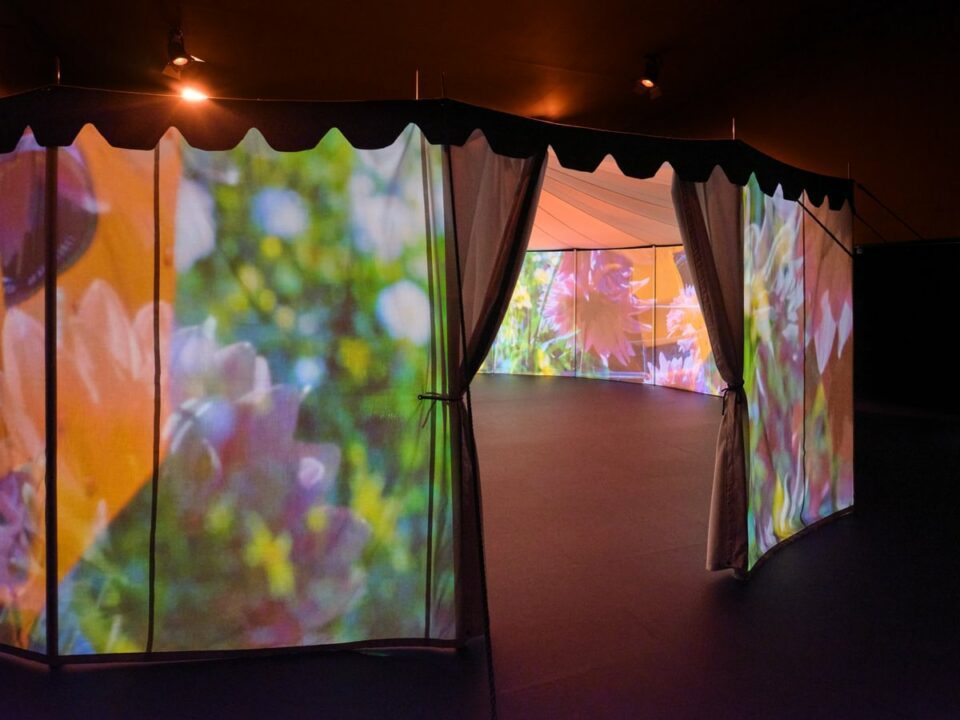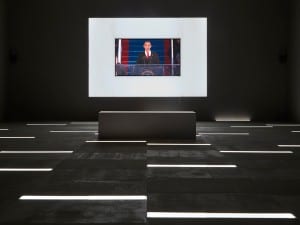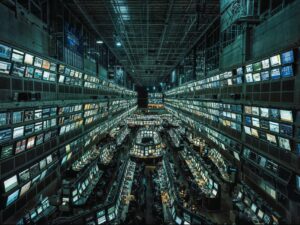Inventor Philo Taylor Farnsworth grew up in a house without electricity until he was 14 years old. Seven years later, in 1927, he was the first person to successfully demonstrated the electronic television. This would prove to be a pivotal moment in technological progress and society’s relationship to it. By the 1960s, 75% of British homes had a television. Leisure became increasing centred around the home, with free time spent in front of the TV, and the industry boomed. The new-found international fixation on the screen soon began to influence the art world. As early as 1958, German artist Wolf Vostell incorporated a TV set into one of his exhibitions, inspiring partitioners with various creative backgrounds to consider including audiovisual component into their work. Yet, it was not until Andy Warhol’s 36-minute film Blowjob (1964), that the idea of video art was popularised. Early pioneers of the form included Bruce Nauman and Nam June Piak, who used televisions to draw attention to the artist process over the finished product. As technology has evolved, so too has video art and today, artists are grappling with questions about how moving images created by AI will shape the future of the medium. The artists included in these exhibitions are all masters of interweaving film and art, some paved the way for video art to become accessible in mainstream galleries and exhibitions, others are gazing forward at the uncertain future we all face. Arthur Jafa uses film to bring to life harsh, often painful lived experiences of marginalized communities. Elsewhere, artists Diana Thater and Josh Kline use their work to unflinchingly imagine dystopian realities, marred by climate change and human destruction. Regardless of the subject, each of these exhibitions uses moving-images to provide an immersive look at the world around us.
Josh Kline’s immersive installation imagines a future sculpted by the ruinous climate crisis and the ordinary people destined to inhabit it. The expanded cinema project began in 2015 and developed in sections over the course of five years. Kline brings video art firmly into the modern era, reflecting the anxieties of a new generation. His dystopian vision of the future is at once unimaginable and terrifyingly close to the truth. In it, rising sea levels have inundated the world’s coasts, unleashing a flood of hundreds of millions of traumatised refugees. He asks: what happens in a world where the systems built to sustain and extend capitalist enterprise and global hegemony begin to crumble? In revealing visions of such a path for humanity, we are invited to imagine ourselves placed within this brutal reality.
Screens: A Panafrica Film Series
The Art Institute of Chicago | Until 6 January
The Art Institute of Chicago welcomes six moving image makers to share their hopes of Panafricanism. The movement envisions a unified African nation where all people of the diaspora can live free from colonialism and white supremacy. This exhibition honours the legacy of the movements during the 1950s and 1960s, when the heyday of decolonisation and civil rights sharpened imaginations and fostered visions of a global connectedness for Black people. Throughout these decades, the moving-image became central to empowering ordinary subjects and shedding light on struggles for justice and human rights. Now, artists in the 21st century recall and re-examine the period, presenting “Panafrica” as a place where arguments about solidarity and freedom are advanced and negotiated through videos.
Galerie Champ Lacombe, Biarritz | Until 5 September
Arthur Jafa (b.1960) is known for his explorations of the complexity of the Black experience through his moving image works. The artist’s seminal film, Love is the Message, the Message is Death (2016) weaves together homemade clips with archival footage documenting police brutality, civil rights marches and prominent black public figures. The seven-and-a-half-minute video sees scenes shift from harrowing incidents such as the assault of a young black girl by police officers, to pop culture moments like Beyonce’s 7/11 music video. In this exhibition, Jafa’s usual visual abundance is stripped back. His film LOML, short for the phrase ‘love of my life’, pays tribute to musician and cultural critic Greg Tate, a friend of the artist who passed away in 2021. It centres the destabilisation and disruption that comes with grief.

Diana Thater: Practical Effects
Luma, Arles | From 1 June
Diana Thater (b.1962) has been a pioneering creator of film and art since the early 1990s. She is best known for her site-specific installations, such as Delphine (1999) and knots + surfaces (2001), which explore the relationship between humans and the natural world. Here, she approaches the idea of post-apocalyptic life through a poignant and wistful lens, following a primate-like robot that is the last being left on Earth. It is tasked with the upkeep of a garden filled with intricately sculpted topiary animals. Devoid of interaction, the colourful robot can only find companionship with the figures it cares for. This video is a strange and tragicomic vision of how the organic and inorganic worlds may collide and support one another in unexpected ways as the Earth shifts and changes due to human behaviour.
Robert Frank’s Scrapbook Footage
Museum of Modern Art, New York | From 15 September
Best-known for his 1958 book titled The Americans, which offered an outsider’s perspective on the country, Robert Frank (1924-2019) explored the realities of life in the US. Yet, from the 1950s to the 1970s, Frank dedicated himself almost entirely to the moving image. In 1959, he created Pull My Daisy, adapted by Jack Kerouac from his own play, to visualise the energy of the Beat Generation. Now, previously unseen footage, tucked away in storage places, film canisters and tapes, will be projected across the Museum of Modern Art. The video art sheds new light on his process and conveys the intimacy and immediacy of Frank’s observations of family, friends and collaborators. In them, we see his appreciation for the fleeting moments of pleasure that make up a contented life.
Words: Emma Jacob
Image Credits:
Josh Kline, Capture and Sequestration: Cigarettes (still) (2023). Single-channel high-definition video (color, sound), 13:31 min. ©
Josh Kline, Submersion (detail) (2019). Glass, urethane paint, light box, reinforced steel, color filter gel, blackout fabric, silicone, dollhouse miniatures, fabricated miniatures, objects cast in resin with urethane pigment, cyanoacrylate glue, and silicone epoxy, 89 3/4 × 48 × 33 in. (227.97 × 121.92 × 83.82 cm). Courtesy of the artist; 47 Canal, New York; and Lisson Gallery, © Josh Kline. Photo by Joerg Lohse.
Diana Thater, Practical Effects, The Tower, Glassroom, Parc des Ateliers, LUMA Arles, France.






